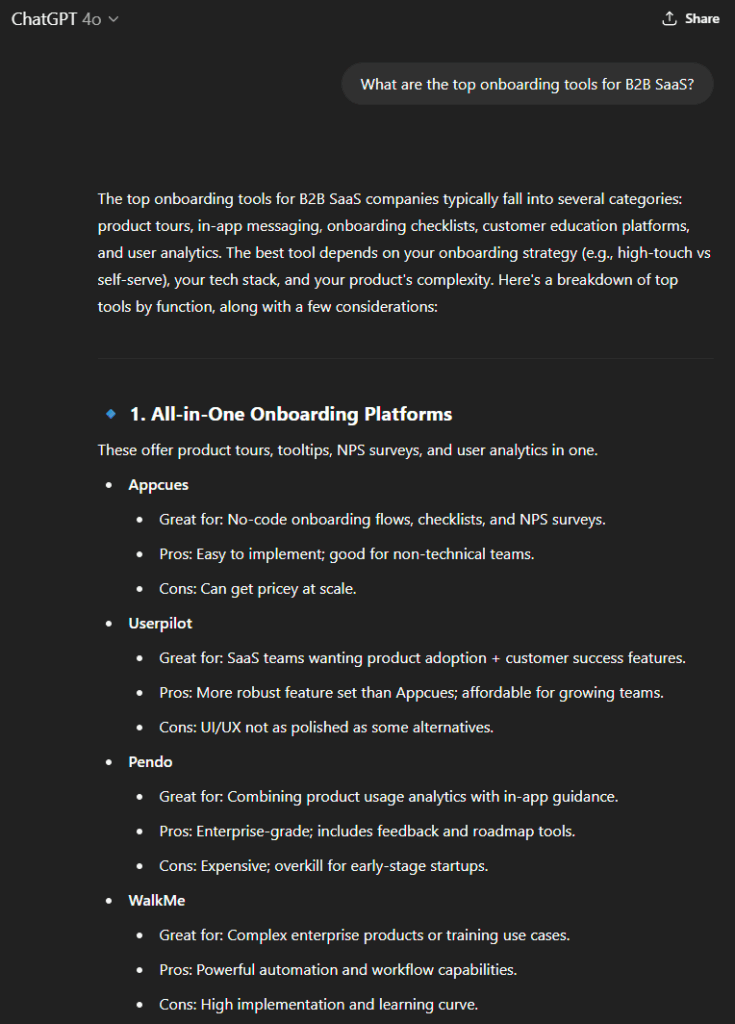There’s a new villain in the B2B dark funnel.
It’s not Slack.
It’s not peers DMing on a LinkedIn.
It’s not some analyst behind a paywall.
It’s ChatGPT.
And it might be recommending your software right now…
Without a single link.
Without attribution.
Without any signal hitting your analytics.
What was the original dark funnel?
This one’s worse.
The old dark funnel was made of whispers.
Buyers talked in private Slack groups. They asked peers. They read analyst reports.
It was messy, but at least we understood the shape of it.
Now?
They’re typing prompts into LLMs.
And those prompts are replacing Google.
Replacing “best of” lists.
Replacing TOFU content.
Replacing your beautifully optimised case study that no one is clicking anymore.
And what do they get back?
A list of tools.
Some summaries.
A few alternatives.
And ideally: your brand name.
But not always a link and therefore no click. No source. No attribution.
You’re in the conversation.
You’re influencing the buyer.
But maybe you’re not capturing it.
AI search has become the ultimate dark funnel
Let’s break it down:
- A buyer asks ChatGPT:
“What are the top onboarding tools for B2B SaaS?” - It replies:
“Products like Appcues, Userpilot, Pendo and WalkMe are commonly used…”
No links. No clicks. No tracking.
Just a brand name floating in a black box.
Here’s an example – not a link in sight.

So is Google / Organic Traffic taking the glory for AI native discovery moments?
If the user decides to search for you later, the visit might show up as “Direct” if they somehow make it to your site by themselves or “Organic” in your reports if they come via Google. But if tools like ChatGPT aren’t providing direct links to your site, then your content team gets no credit. Your paid team gets no insight. And your attribution is even more broken than you thought.
It’s clear that adoption of AI tools like ChatGPT is on the rise, and that use of ‘traditional’ Google searches is falling. AI assistants are now buyer enablement co-pilots supporting the length of the B2B buyer journey, and they are trusted by buyers as sources of truth.
| What’s Happening | Why It’s a Problem |
|---|---|
| You’re getting mentioned in AI search responses | But often with no click or traceable visit |
| Buyers are discovering you through prompts | But you have no way of knowing when or why |
| You’re influencing consideration | But your CRM, GA, and attribution tools don’t show it |
| Your “Direct” traffic is rising | But no one can explain why |
| Your ‘Organic’ might look like it’s staying the same | But it might be lying to you |
So what do you do?
You fight back. Smartly.
- Audit Your Prompt Visibility
Use AI tools like Peec to find out if and where you’re showing up in AI responses. - Optimise for LLMs, Not Just Google
Structure your content so it’s prompt friendly – clear answers, concise summaries, comparative content, semantic markup. - Track Branded Search as a Proxy
Start mapping when your branded search spikes after known prompt exposure – it’s not perfect, but it’s something. - Double Down on Name Recall
If the link’s not coming, your name needs to stick. Make sure you’re the tool they remember (and spell correctly) when they leave ChatGPT. - Rethink Attribution Entirely
The buyer journey is nonlinear and AI-assisted now. Build models that reflect influence, not just clicks.
If you’re not actively managing how your brand shows up in generative search – and understanding that visibility ≠ attribution then you’re flying blind – maybe now is the time to start building the business case for investing in AI search.
Want to see if your brand is already showing up in AI search? We can tell you.